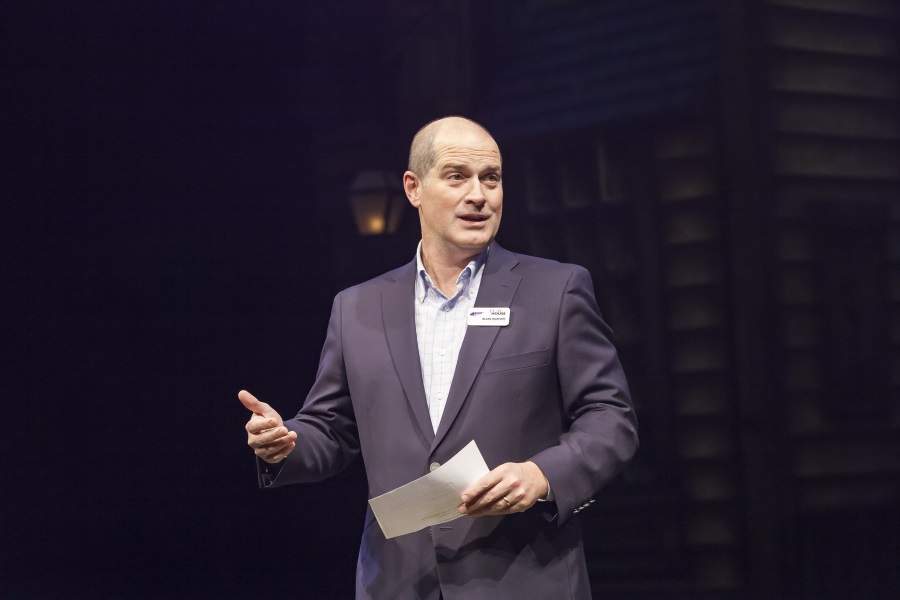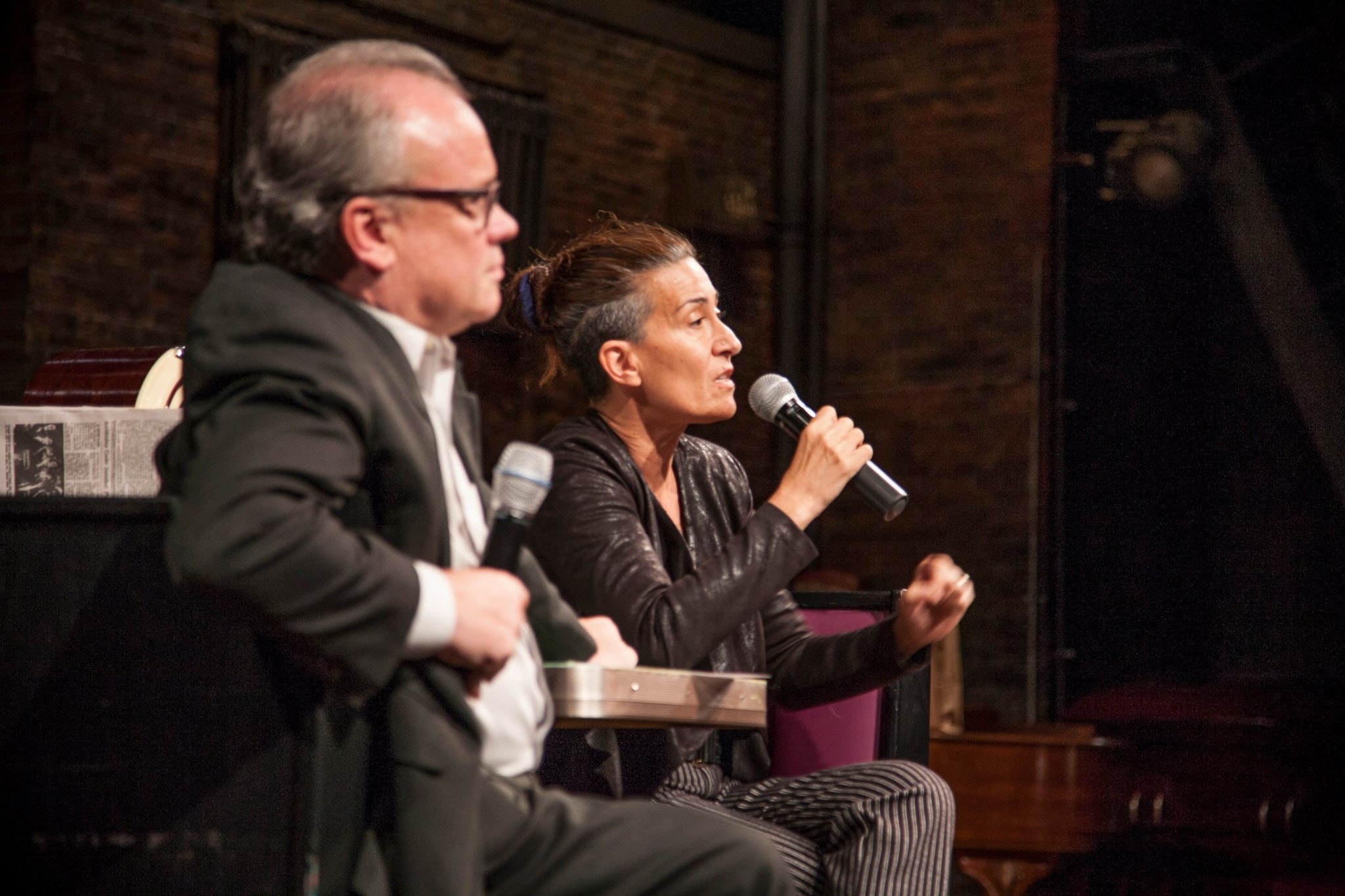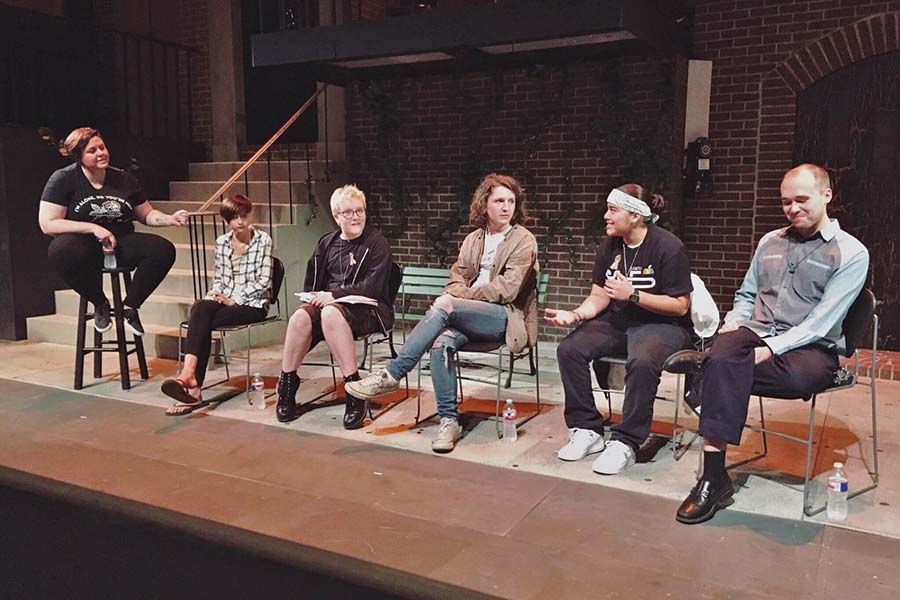David Mamet caused a stir last year when he decided to ban talkbacks after his shows, even going so far as including a fine of $25,000 for any unauthorized post-show discussion in his licensing arrangements. It’s easy enough to decry such a rule as an authoritarian impulse, but the fact is that plenty of playwrights and theatre artists over the years have expressed skepticism, if not quite hostility, about the whole panel-after-a-performance ritual and its purported value.
Anne Washburn, author of Mr. Burns, a Post-Electric Play, described what she called “talkback exasperation” in a 2017 interview with Stuart Miller in the Los Angeles Times. The problem is particularly acute, Washburn suggested, in an era when playwrights are playing with a new deck of dramaturgical cards. “Plays are very complicated events taking place in real time, with no chance to rewind or to stop and reflect,” she told Miller, “and a lot of the new playwriting likes to toggle with the rules.”
Notwithstanding that challenge, public engagement with audiences in talkbacks of one form or another has generated what almost amounts to a parallel season of programming at a number of theatres around the country: Post-show discussions, community panels, and other innovative gatherings form the tip of the spear for community engagement and education. We talked to the artistic leaders of a few of these theatres about what they’ve found that works—and doesn’t work—in crafting talkbacks and other show-related events.
PLAYWRIGHTS HORIZONS, New York City
Tim Sanford, artistic director of Playwrights Horizons since 1996, says the theatre’s longstanding program of talkbacks with playwrights started out as a perk for subscribers. “Not that anyone can’t go,” he hastens to add, “but the talkbacks are always in our subscriber bulletin, and people who enjoy them know when they’re going to be and can book for those performances. That was our basic motivation.”
The Manhattan-based theatre usually schedules three talkbacks with each playwright during the run of their show, with Sanford himself in charge of the proceedings. “They also do patron events,” notes Sanford of the playwrights on his roster, “one before the show and one after. When we do them after the show, it’s usually with something like a young patrons’ group, which we call Generation PH—these events might be more, quote-unquote, intimate—we might bring actors into those.
“But unless the playwright really wants me to, I don’t like to invite actors to our talkbacks,” Sanford continues, “particularly since they are usually scheduled during the preview period, when actors are still solidifying their performances in front of the audience.” And, Sanford adds, “I rarely find that actors get asked interesting questions.”
Do playwrights find comments and questions from audiences helpful at this stage of the process? “I do think there are some playwrights who aren’t curious about what notes they might be given [from the audience],” Sanford concedes, “but they are curious about information, or about specific places in the story where audience members had a lot of questions. I’d say the primary purpose is just emphasizing that the audience is important—giving them a chance to have an interaction with the writer is what we call engagement these days.”
But sculpting the shape of that discussion requires its own skill set. “I had it slowly sink in, maybe four or five years ago, that talkbacks weren’t necessarily the most fun experience for writers,” says Sanford. “That prompted me to take a different tack, which was to start the talkbacks as a conversation between myself and the writer. I would open up and lay out the context, maybe ask them why they wrote the play, start it conversationally, try to bring the director in, and then turn to the audience. I do think that’s been successful at putting the writers at ease, and it also makes it a little easier if someone asks a question that seems off-base to me, or sounds critical, or not helpful. I find it easier just to jump in, having already talked plenty.”
One of the innovations that Playwrights Horizons has recently introduced brings in patrons as docents for new work, via the theatre’s “Perspectives On Playwriting” course, taught by playwrights who have been produced at the theatre. (Recent guest instructors have included Washburn and playwright/director Robert O’Hara.) “It’s really not a class for playwrights,” Sanford emphasizes. “The purpose of it is to give that limited audience that is able to join the class and pay for it an appreciation that there are no set rules for how to write a play, and that playwrights enter their material in different ways.”
From those who have attended the class more than once, Playwrights chooses the docents who lead “POP Talks,” a program add-on that Sanford describes as “curated conversations that are not led by staff members.” So far this approach has been a big success. “We’ve only done or two per show, but we’re going to start putting these into our subscriber bulletin as well.”
Sanford summarizes his goals succinctly: “My main purpose in having talkbacks is to emphasize that the plays we present are works of art, and that they are digging deeply into themes and artistic forms—and to try to get the conversation about that to go someplace interesting. We want the afterlife of the play to exit the theatre with each audience member.”

CINCINNATI PLAYHOUSE IN THE PARK, Ohio
For Blake Robison, now in his seventh year as artistic director of Cincinnati Playhouse in the Park, talkbacks are “conversations among audience members themselves. We are there to moderate and add a little bit of expertise.” That has led to what Robison calls “parallel programming,” related events for plays that “invite deeper discussions,” such as the theatre’s 2016 production of Ayad Akhtar’s Disgraced and the 2015 production of Tracey Scott Wilson’s Buzzer.
“These events happen around more dense and meaty plays that dig into societal issues or racial issues,” Robison notes, “things we think people need or want to talk about right after the show. We deliberately do not have the actors come out for those, because then it becomes about, ‘Oh, I loved your performance, how did you learn your lines, what research did you do,’ etc.”
Several of these talkbacks have brought in community leaders involved with the issues raised by the play. For instance, Buzzer, which deals with problems of gentrification and race, led to discussions about the economic status of downtown Cincinnati, with talkback participants who Robison describes as “stakeholders in the community, onstage with the Playhouse staff.”
He views the events the theatre created around Disgraced as the most successful to date. “We partnered with Bridges of Faith Trialogue, an organization that brings together civic and business leaders from the Christian, Muslim, and Jewish communities—they took part after every single performance,” says Robison. “A member of the Playhouse artistic staff would join the featured guests, and we would ask them to respond from their vantage point. After that, we would break into a full audience discussion.”
While actors are not immediately involved in most talkbacks at the Playhouse, Robison did create a unique opportunity for one of the actors in Disgraced to revisit the play—one year later. Barzin Akhavan, who played Amir, the corporate lawyer who has largely cast aside his Muslim heritage, returned to Cincinnati for a discussion with Robison. (The a.d. notes that, while Akhavan wasn’t formally involved in other post-show discussions during the run of Disgraced, he did sneak into the back row of the house for every single one.)
“Barzin was in our production of Shakespeare in Love a year after Disgraced,” Robison explains, “and we thought it would be interesting to invite anyone who had seen Disgraced to come back a year later and talk about how the play has sat with them over the past 12 months. We had had a presidential election and a lot of fascinating stuff happen in the meantime that might trigger memory or self-reflection.”
Speaking about it a year later, Akhavan described hearing those post-show discussions about Disgraced from the back of the house every night as “life-saving.” Why so important? “The role put so much pressure on my physical being, and every night that I watched those talkbacks, it made it worth it. I was surprised, I was shocked, I was angered, I was hurt, I was hopeful. All the range of emotions and experiences you could have—I found them in each and every one of those discussions at some point.”
Robison points out that bringing in community leaders from outside the theatre requires its own measure of training for those leaders, who may not understand the nature and purpose of the talkback.
“When we were working with Bridges of Faith, the original idea was that they would be moderating their own discussions. It only took one or two of those sessions to realize it wasn’t a good idea. Theatre people who have done these events before need to be there as a referee for the audience, just to make sure no one person dominates and that everyone gets a chance to speak—even if they’re not the person with their hand up the highest or looking at you the most.”
In those cases, Robison says, with a measure of satisfaction, “I find often that it’s the audience who gets things back on track. If one person says something highly objectionable, you’ll find a dozen other audience members who will rise up and say ‘no.’”

VICTORY GARDENS THEATER, Chicago
Chay Yew has been artistic director of Chicago’s Victory Gardens Theater since 2011. Before that he was a playwright and director. What did he think of talkbacks in those earlier years?
“I hated them. I always hated them,” Yew declares. But he adds, “When I first came to Victory Gardens, it was important for me to understand the audience. So I slipped into a talkback to see who I would be speaking for in the next few years.”
Yew was taken aback. “I was surprised that the audiences responded so well to how they felt about the play! They never asked, ‘How do you learn those lines?’ or ‘Why did this character have to die?’ They started with their experiences, and that gave me an immediate idea: This can be a wonderful platform for our audiences to connect with other audiences. I said there and then, ‘We’re going to have talkbacks every night.’ It freaked my staff out.”
As Yew’s season programming also frequently focuses on social-justice issues and marginalized voices, Victory Gardens began inviting “community partners” to participate in panel discussions, which alternate with post-show talkbacks led by the theatre’s staff.
“Our Chicago audiences are very curious and very hungry to talk and to be heard,” Yew reports. “They might say, after they saw Marcus Gardley’s The Gospel of Lovingkindness [2014], ‘I don’t know what this play has to do with my community, because it’s just black-on-black violence.’ And then across the aisle, someone would shoot back, ‘Yes, we understand what you’re saying, to some extent. But don’t you understand? The bullet has no zip code. Eventually the bullet will land in your community.’”
In putting together panels relating to each play, Yew says what often works is to keep the numbers small, “maybe three guests who come in. What is really electrifying sometimes is to bring in people with their own stories or experiences that match those in the play; we also invite people from academia, or social-justice advocates, or social workers, or even Congresswomen.”
Yew recalls a community program Victory Gardens organized around its 2014 production of Ariel Dorfman’s Death and the Maiden, a play about the Chilean reign of terror under Augusto Pinochet in the 1970s and ’80s.
“We decided to have a group of people talk about what violence and torture means here in Chicago,” notes Yew. “We brought up a gentleman who was wrongly arrested during the Jon Burge regime.” Burge, a former Chicago Police Department detective and area commander, was convicted in 2010 of obstruction of justice and perjury in relation to many allegations of torture of suspects in his custody. The panelist, Yew says, “told a story about how the police drove him out to an unfamiliar place, made him get out of his car, and put a gun to his mouth. As he was telling us this, he started breaking down. A play set as far away as Chile now has an immediate impact.”
More recently, Yew notes that discussions with recently incarcerated women, held last spring around Boo Killebrew’s Lettie (a play about a woman paroled after years in prison on drug charges), led to a theatre-led drive for books, toiletries, and other items the women mentioned would be useful as they re-entered life outside of jail.
Yew’s goal for all the company’s talkbacks and post-show programming, he says, can be boiled down to a series of questions: “What is the present tense of this play? How can we facilitate its message? What are you, sitting in the audience, going to do in response? You have some power to make it a better world.”

WATERTOWER THEATRE, Addison, Texas
Joanie Schultz became artistic director of WaterTower Theatre in Texas after a long stint as a freelance director in Chicago, including work at Victory Gardens. After 18 months on the job, she feels that the talkbacks she’s instituted are starting to pay off for artists and audiences alike.
The first project she undertook, Ike Holter’s Stonewall-era play Hit the Wall, replaced a previously announced production of Sunday in the Park with George. “We did as much engagement with the LGBTQ community as we possibly could,” Schultz emphasizes. “That was our introduction to community engagement, and discovering ways we could help our plays intersect with all the different communities around us and the things going on in the world.”
The production provided the occasion for panel discussions with “people who could speak about the status of [LGBTQ rights] in that moment, and what was going on in Texas in that struggle. Turns out there was a lot in our state government to be concerned about—a bathroom bill, all kinds of repressive stuff like that coming up.”
Plays like Hit the Wall, with a strong social-justice or timely angle, tend to be an easier starting point for creating parallel programming, Schultz reasons. For Kate Hamill’s adaptation of Pride and Prejudice, which ran last October, she admits, “It was a little harder. We ended up with a scholar who could talk about rebellious women in literature, and we also had a modern-day matchmaker come in. I got to interview her, and it turned out to be really fascinating.”
Schultz is also aware that asking people with close emotional connections to a story to appear onstage can be tricky. For Quiara Alegría Hudes’s Elliot, a Soldier’s Fugue, which ran in winter 2018, “It was hard to get veterans who wanted to talk about their war experiences. We did end up hearing from one panel of veterans.”
Talkbacks, for many reasons, aren’t always sweetness and light. Schultz recalls one from her time at Victory Gardens during the run of Gardley’s An Issue of Blood, which she calls “a really intense play about black-white relations. A guy in the post-show, an older white man, stood up and started saying all this stuff about how racism doesn’t exist, and white men were getting ostracized—it was one of those moments I felt I didn’t know how to handle. There was a Ph.D student, an African American man, in the audience, and he ended up asking the other guy the right questions. I felt guilty that he was the one to salvage that situation.”
Still, Schultz thinks there is value even in such tense moments. “What we’re asking for is discourse. And we’re not super-good as a society at having discourse and disagreeing with each other. I really want our theatres to be a safe place for dialogue. I think the disagreements can be a kind of training gym, where maybe we can learn to disagree with each other better for the rest of our lives.”
Kerry Reid writes regularly for this magazine. This story was made possible in part with support from TCG’s Audience (R)Evolution program, funded by the Doris Duke Charitable Foundation.


